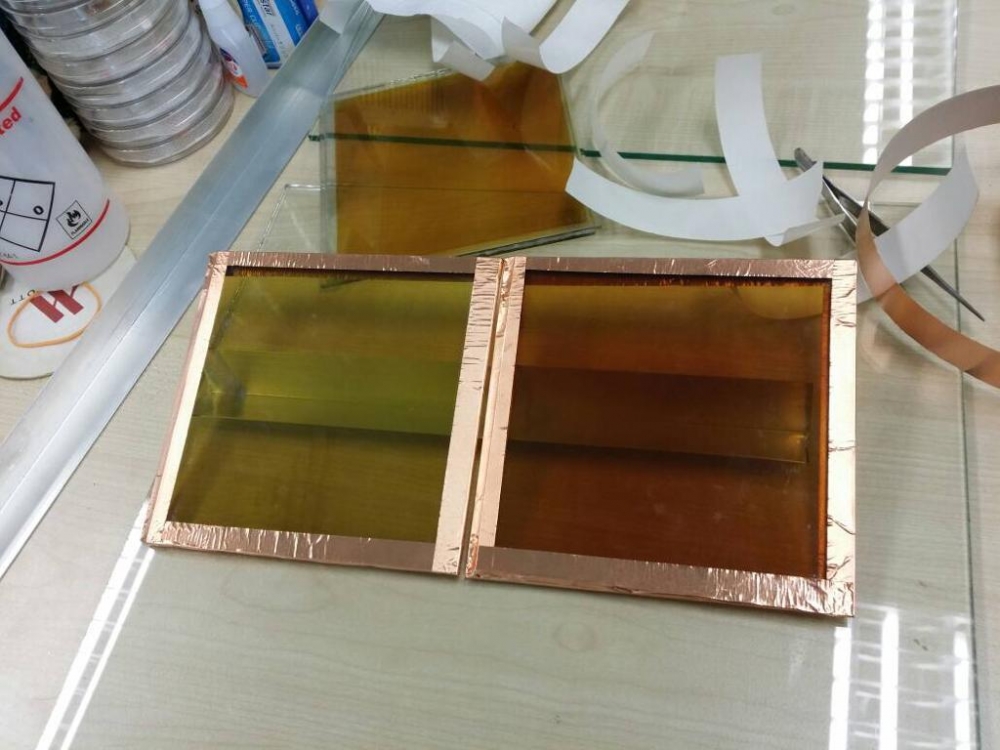Electron transport studies of dye-sensitized solar cells based on natural sensitizer extracted from rengas (Gluta spp.) and mengkulang (Heritiera elata) wood
The development of the dye-sensitized solar cell (DSSC) as an alternative device in solar energy applications has been extensively investigated. DSSCs have advantages such as lower cost and less toxic manufacture than conventional silicon-based cells (Shalini et al. 2015). Generally, DSSC devices are composed of a photoelectrode including the wide bandgap semiconductor metal oxide with adsorbed dye molecules and a counter-electrode made of a catalyst such as platinum covering the conducting glass. A mesoporous metal oxide such as TiO2, ZnO, SnO2, and Nb205 that is coated on the conducting glass is sintered to allow electronic conduction (Narayan 2012). Among them, anatase TiO2, which has high dielectric constant, is the most common material used, as it provides good electrostatic shielding of the injected electron which then prevents from the recombination effects. The high refractive index of anatase TiO2 also leads to an efficient light scattering effect inside the porous photoelectrode, which is important to enhance light harvesting efficiency (Olea et al. 1999). The electrolyte is injected in between the electrodes to help in electron transport and in restoring reduced sensitizer. The most common electrolytes used are composed of the redox couples iodide/triiodide dissolved in liquid organic solvent (Faccio et al. 2011)
The principle of DSSC was proposed to mimic photosynthesis; the ability of the device to harvest visible light and convert chemical energy into electricity is very important (Koyama et al. 2009). Light is absorbed by a component known as the sensitizer, which is grafted on the TiO2 surface of the photoelectrode. The role of the sensitizer is to supply electrons throughout the cell after being oxidized in the visible light range (380 nm to 800 nm). Generally, the sensitizer is made of metal-organic dyes, organic dyes, or natural derivative dyes.
The most stable and high conversion efficiency have been achieved with ruthenium (Ru) polypyridal compounds, such as cis-dithiocyanobis(4,4’-di-carboxy-2,2’- bipyridine) ruthenium(II) (N3), ditetrabutylammonium-cis-bis(isothiocyanato)bis(2,2’- bipyridyl-4,4’-dicarboxylatol)ruthenium(II) (N719), and tris-tetrabutylammonium tri- thiocyanato-4,4’,4”-tricarboxy-2,2:6’,2”-terpyridineruthenium(II) (black dye) (Nazeeruddin et al. 2001; Marwa et al. 2016; Wang et al. 2016). Although the conversion efficiency of ruthenium complex dyes is greater than 10%, there are some disadvantages that limit their potential. For instance, ruthenium is a rare, expensive metal that is not environmentally friendly (Adeloye and Ajibadebu 2014).
Organic dyes also are efficient sensitizers because of their satisfactory stability and large molar absorption coefficient (Zeng et al. 2014). Because organic dyes are metal-free, there is no concern about resource limitation, and their stereochemical structure can be modified (Ooyama and Harima 2012). The modification of molecular structures adjusts the absorption properties and rearranges the energy level of the sensitizer, resulting in better conversion efficiency. However, most molecular modifications of organic dyes require complicated synthesis procedures (Hara et al. 2005). Among the organic dyes, porphyrin-based DSSC has achieved a high conversion efficiency of 13% (Mathew et al. 2014).
Natural pigments are good alternative sensitizers because of the simple extraction procedure, low cost, and low environmental impact. These abundant natural pigments are present in some fruits, flowers, and leaves of plants; they contain compounds that strongly absorb visible light at different wavelengths, resulting in different visible colors (Lim et al. 2015). Several natural pigments have been extensively investigated, such as chlorophyll (Wang et al. 2010), anthocyanin (Ozuomba et al. 2013), xanthophyll (Kartini et al. 2015), and carotene (Shanmugam et al. 2013). While the conversion efficiencies achieved (< 3%) are much lower than the industrial requirements (Basheer et al. 2014), numerous studies have investigated various plant species as sources of sensitizers.
This study examines the performance of dye-sensitized solar cells based on natural sensitizers extracted from rengas (Gluta spp.) and mengkulang (Heritiera elata) wood. The highlight in this study is the electron transport mechanism inside the cells, which will predict any fault in the devices. The three types of sensitizers examined were an individual sensitizer (extracted from rengas (Gluta spp.) and mengkulang (Heritiera elata) wood), a mixture sensitizer (mixing both of the individual dyes), and a co-sensitizer (individual sensitizer co-sensitized with ruthenium (N719) dye). This study found that the mixture sensitized DSSCs exhibited good conversion efficiency (0.21% and 0.30%) compared with individual sensitized DSSCs (0.16% and 0.11%). The co-sensitized DSSCs also showed increased conversion efficiency with ruthenium (N719) dye as a co-sensitizer. The parameters calculated from EIS analysis were used to determine suitable conditions for the dye to be implemented in DSSC. The behavior of electron transport was determined to be efficient due to the increase of electron diffusion coefficient, electron lifetime, and low recombination rate as achieved by the mixture sensitized DSSCs.
The principle of DSSC was proposed to mimic photosynthesis; the ability of the device to harvest visible light and convert chemical energy into electricity is very important (Koyama et al. 2009). Light is absorbed by a component known as the sensitizer, which is grafted on the TiO2 surface of the photoelectrode. The role of the sensitizer is to supply electrons throughout the cell after being oxidized in the visible light range (380 nm to 800 nm). Generally, the sensitizer is made of metal-organic dyes, organic dyes, or natural derivative dyes.
The most stable and high conversion efficiency have been achieved with ruthenium (Ru) polypyridal compounds, such as cis-dithiocyanobis(4,4’-di-carboxy-2,2’- bipyridine) ruthenium(II) (N3), ditetrabutylammonium-cis-bis(isothiocyanato)bis(2,2’- bipyridyl-4,4’-dicarboxylatol)ruthenium(II) (N719), and tris-tetrabutylammonium tri- thiocyanato-4,4’,4”-tricarboxy-2,2:6’,2”-terpyridineruthenium(II) (black dye) (Nazeeruddin et al. 2001; Marwa et al. 2016; Wang et al. 2016). Although the conversion efficiency of ruthenium complex dyes is greater than 10%, there are some disadvantages that limit their potential. For instance, ruthenium is a rare, expensive metal that is not environmentally friendly (Adeloye and Ajibadebu 2014).
Organic dyes also are efficient sensitizers because of their satisfactory stability and large molar absorption coefficient (Zeng et al. 2014). Because organic dyes are metal-free, there is no concern about resource limitation, and their stereochemical structure can be modified (Ooyama and Harima 2012). The modification of molecular structures adjusts the absorption properties and rearranges the energy level of the sensitizer, resulting in better conversion efficiency. However, most molecular modifications of organic dyes require complicated synthesis procedures (Hara et al. 2005). Among the organic dyes, porphyrin-based DSSC has achieved a high conversion efficiency of 13% (Mathew et al. 2014).
Natural pigments are good alternative sensitizers because of the simple extraction procedure, low cost, and low environmental impact. These abundant natural pigments are present in some fruits, flowers, and leaves of plants; they contain compounds that strongly absorb visible light at different wavelengths, resulting in different visible colors (Lim et al. 2015). Several natural pigments have been extensively investigated, such as chlorophyll (Wang et al. 2010), anthocyanin (Ozuomba et al. 2013), xanthophyll (Kartini et al. 2015), and carotene (Shanmugam et al. 2013). While the conversion efficiencies achieved (< 3%) are much lower than the industrial requirements (Basheer et al. 2014), numerous studies have investigated various plant species as sources of sensitizers.
This study examines the performance of dye-sensitized solar cells based on natural sensitizers extracted from rengas (Gluta spp.) and mengkulang (Heritiera elata) wood. The highlight in this study is the electron transport mechanism inside the cells, which will predict any fault in the devices. The three types of sensitizers examined were an individual sensitizer (extracted from rengas (Gluta spp.) and mengkulang (Heritiera elata) wood), a mixture sensitizer (mixing both of the individual dyes), and a co-sensitizer (individual sensitizer co-sensitized with ruthenium (N719) dye). This study found that the mixture sensitized DSSCs exhibited good conversion efficiency (0.21% and 0.30%) compared with individual sensitized DSSCs (0.16% and 0.11%). The co-sensitized DSSCs also showed increased conversion efficiency with ruthenium (N719) dye as a co-sensitizer. The parameters calculated from EIS analysis were used to determine suitable conditions for the dye to be implemented in DSSC. The behavior of electron transport was determined to be efficient due to the increase of electron diffusion coefficient, electron lifetime, and low recombination rate as achieved by the mixture sensitized DSSCs.



